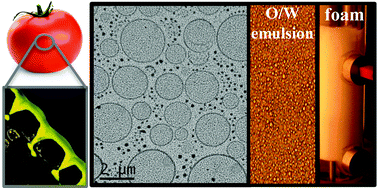Interfacial properties of functionalized assemblies of hydroxy-fatty acid salts isolated from fruit tomato peels
Abstract
Fruit peels are waste by-products generated by industrial tomato processing. The cuticular fraction of tomato peels is composed of a polyester, rich in hydroxy-fatty acids. After depolymerization, these fatty acids are isolated and easily dispersed in water into unilayer vesicles by using lysine and choline counter-ions. These vesicles form highly stable oil–water emulsions and display good foamability. These results illustrate the promising potential of tomato peel hydroxy-fatty acids as green surfactants.


 Please wait while we load your content...
Please wait while we load your content...